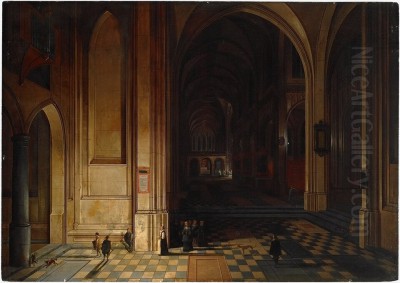
Peeter Neeffs the Elder stands as a significant figure in the rich tapestry of Flemish Baroque art. Active primarily in Antwerp during the late 16th and first half of the 17th century, he carved a distinct niche for himself, becoming one of the foremost painters specializing in architectural interiors, particularly those of churches. His meticulous renderings of Gothic cathedrals, characterized by their sophisticated grasp of perspective and masterful handling of light, offer viewers a serene and detailed glimpse into the sacred spaces of his time. His work not only captured the grandeur of these structures but also contributed to a specific genre that found considerable appreciation among collectors.
Origins and Early Influences
The precise birth year of Peeter Neeffs remains a subject of some scholarly debate, though the consensus leans towards approximately 1578. He was born in Antwerp, a city that, despite recent political and religious turmoil, was re-emerging as a vibrant artistic hub. His father, Aart Neeffs, was an innkeeper, suggesting that Peeter's path into the arts was perhaps not predetermined by immediate family tradition in painting, unlike some other artistic dynasties of the period. However, the environment in Antwerp was undoubtedly stimulating for a young aspiring artist.
Crucial to Neeffs's development was the influence of the Steenwijk family of painters. Both Hendrick van Steenwijk the Elder (c. 1550–1603) and, more significantly, his son Hendrick van Steenwijk the Younger (c. 1580–1649) were pioneers in the field of architectural interior painting. The younger Steenwijk, a near contemporary of Neeffs, had worked in Antwerp before moving to London. His innovative approaches to perspective and his depictions of church interiors, often illuminated by artificial light sources, clearly left a lasting impression on Neeffs. Neeffs likely studied their work closely, absorbing their techniques before developing his own distinct style.
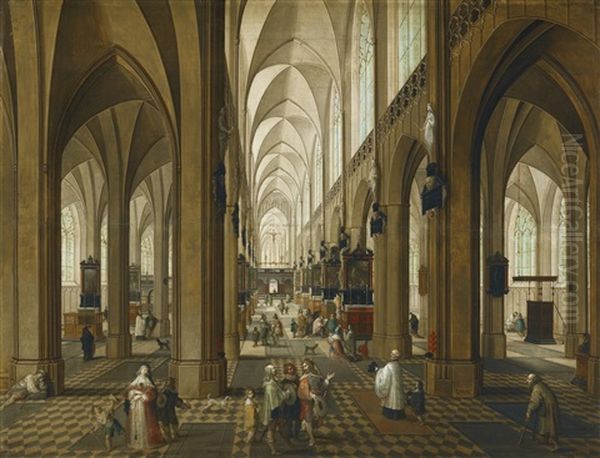
By 1609, Peeter Neeffs the Elder had achieved sufficient mastery and recognition to be accepted as a master painter into the prestigious Antwerp Guild of Saint Luke. This membership was essential for any artist wishing to practice independently, take on pupils, and sell their work legally within the city. It marked the formal beginning of a long and productive career dedicated almost exclusively to his chosen specialization.
Artistic Style: Perspective and Light
The hallmark of Peeter Neeffs the Elder's oeuvre is his dedication to the accurate and atmospheric depiction of church interiors. He overwhelmingly favored Gothic architecture, with the soaring arches, ribbed vaults, and intricate tracery of Antwerp Cathedral featuring frequently in his work. He painted its interior numerous times, exploring different viewpoints, lighting conditions, and times of day, demonstrating an intimate knowledge of the building.
Neeffs possessed an exceptional command of linear perspective, a skill vital for rendering the complex spatial recession of large architectural structures convincingly. His paintings draw the viewer's eye deep into the depicted space, along colonnades and towards distant altars or windows. He employed a precise, almost draftsman-like technique, often working on copper panels. The smooth surface of the copper allowed for extremely fine detail and delicate brushwork, enhancing the sense of realism and refinement in his paintings. Wood panels were also used.
Equally important was his handling of light. Neeffs was adept at capturing both the cool, diffuse light filtering through stained-glass windows during the day and the dramatic, localized glow of candles or torches in nocturnal scenes. His night interiors are particularly noteworthy, creating a sense of mystery and quiet devotion through the interplay of deep shadows and warm, artificial light sources. This fascination with varied lighting effects distinguishes his work and adds significantly to its atmospheric quality, likely building upon the innovations of Hendrick van Steenwijk the Younger.
The Antwerp Artistic Milieu
Neeffs worked during a period of resurgence for Antwerp. Following the turbulent years of the Dutch Revolt and the Spanish Fury, the city, under the administration of the Archdukes Albert and Isabella, experienced a period of relative stability and economic recovery known as the Pax Hispanica. This era coincided with the Counter-Reformation, which spurred demand for religious art. While Neeffs's architectural scenes were not devotional images in the same way as large altarpieces, their focus on sacred spaces resonated with the prevailing religious sentiment.
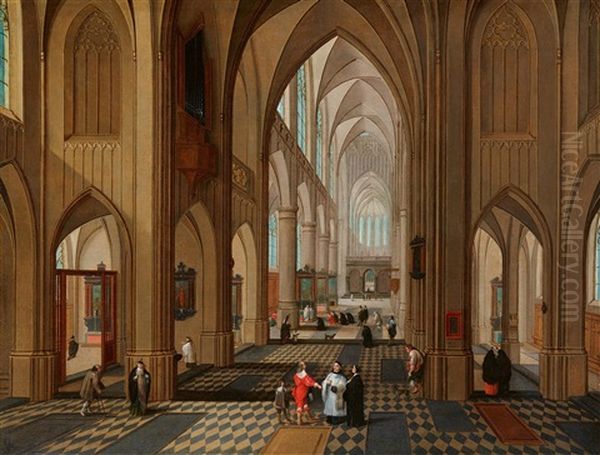
Antwerp was bustling with artistic talent. Neeffs was a contemporary of giants like Peter Paul Rubens (1577–1640), Anthony van Dyck (1599–1641), and Jacob Jordaens (1593–1678). While Neeffs operated in a different, more specialized genre than these masters of history painting and portraiture, he was part of the same vibrant artistic ecosystem. The city's Guild of Saint Luke fostered a high level of craftsmanship and facilitated interactions and collaborations between artists.
Collaboration and Staffage
A common practice in 17th-century Antwerp, particularly among specialist painters, was collaboration. Masters of landscape, still life, or architecture would often team up with figure painters (known as 'staffage' painters) to complete a single artwork. Peeter Neeffs the Elder frequently engaged in such collaborations. While he was a master of rendering architecture, the small figures populating his church interiors were typically added by other artists.
His most frequent collaborators included members of the prolific Francken family, especially Frans Francken the Younger (1581–1642) and possibly his son Frans Francken III (1607–1667). The elegant, somewhat elongated figures typical of the Francken style can often be seen attending mass, conversing, or strolling through Neeffs's cathedrals.
Other notable collaborators included Jan Brueghel the Younger (1601–1678), who continued the Brueghel dynasty's tradition of detailed work, and David Teniers the Younger (1610–1690), renowned for his peasant scenes but also a versatile figure painter. Occasionally, figures by artists like Sebastiaen Vrancx (1573–1647), known for battle scenes but also capable genre figures, or the landscape and figure painter Adriaen van Stalbemt (1580–1662) might appear in his works. These collaborations added narrative interest and human scale to his architectural settings, making the spaces feel inhabited and alive.
Representative Works
Peeter Neeffs the Elder produced a consistent body of work, refining his themes rather than drastically changing his style. Several paintings stand out as representative of his skill and focus:
_Interior of Antwerp Cathedral_: Neeffs painted numerous versions of this subject, his hometown's magnificent Gothic cathedral. These works showcase his ability to capture the grandeur of the space from various angles, often looking down the nave towards the choir or focusing on side aisles. He depicted it in daylight, sometimes with specific events like sermons taking place, and also in evocative night scenes illuminated by candlelight. Each version highlights his mastery of perspective and light within this familiar setting.
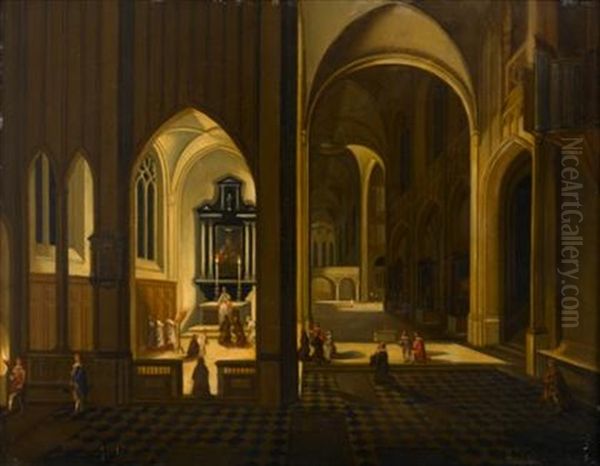
_Interior of a Gothic Church_: This title often applies to many of his works where the specific church is not identified or is perhaps a composite or idealized Gothic structure. These paintings consistently demonstrate his core strengths: meticulous architectural detail, convincing spatial depth, and careful attention to the play of light and shadow across columns, vaults, and floors. The figures within, often painted by collaborators, provide scale and context.
_Church Interior at Night_: Neeffs excelled at nocturnal scenes. These paintings often feature dramatic contrasts between the deep darkness of the unlit portions of the church and the warm, flickering light cast by candles or torches illuminating small groups of figures or specific architectural features like altars or tombs. They possess a unique atmosphere of quiet contemplation or hushed activity.
_Interior of the Sint-Jacobskerk, Antwerp_: Besides the Cathedral, Neeffs also depicted other significant Antwerp churches, such as the Sint-Jacobskerk (St. James' Church), famous as the burial place of Rubens. These works further demonstrate his commitment to documenting the sacred architecture of his city.
These works, often modest in size but rich in detail, were highly sought after by collectors who appreciated their technical virtuosity and serene atmosphere.
Family, Workshop, and Legacy
Peeter Neeffs the Elder established not only a successful career but also an artistic dynasty. In 1612, he married Maria Lauterbeens. The couple had five children, born between 1614 and 1623. Significantly, two of their sons, Lodewijk Neeffs (1617–after 1648) and Peeter Neeffs the Younger (1620–after 1675), followed in their father's footsteps, becoming painters specializing in the same genre of church interiors.
Both sons worked in a style very close to their father's, often collaborating with him and eventually producing independent works. Peeter the Younger, in particular, became a capable artist in his own right, continuing the family tradition well into the latter half of the 17th century. The similarity in style and subject matter between the father and his sons, coupled with shared workshop practices, has sometimes led to difficulties in attribution. Distinguishing the hand of Peeter the Elder from that of Peeter the Younger or Lodewijk can be challenging for art historians, especially for unsigned works from the middle period of the Elder's career when his sons were active in the workshop.
Besides his sons, Neeffs is known to have had at least one documented pupil, Laureys de Cater, who was registered with the Guild in 1630. The Neeffs workshop likely produced a considerable number of church interiors, catering to a steady market demand.
Later Life and Enduring Recognition
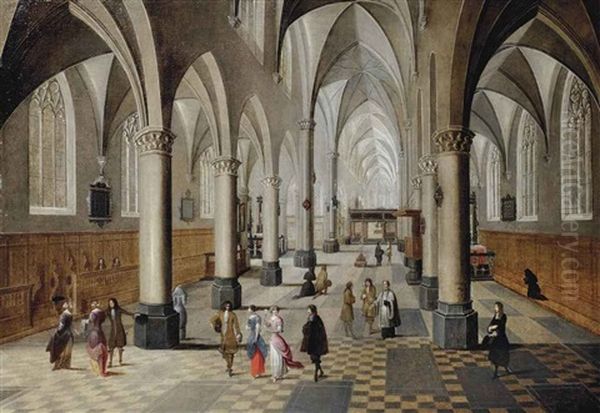
Peeter Neeffs the Elder remained active as a painter for many decades. Records show his wife, Maria Lauterbeens, passed away in 1655 or 1656. Neeffs himself is documented as being alive in 1656, but the exact date of his death is unknown. It is generally believed to have occurred sometime between 1656 and 1661 in Antwerp.
His legacy lies in his contribution to the specialized genre of architectural painting within the broader Flemish Baroque. While perhaps not as revolutionary as Rubens or Van Dyck, Neeffs achieved excellence within his chosen field. He perfected a formula for depicting church interiors that was both technically accomplished and aesthetically pleasing. His influence is most clearly seen in the work of his sons, who carried his style forward. His work might also be seen in dialogue with similar developments in the Dutch Republic, where painters like Dirck van Delen (1604/5–1671) and Bartholomeus van Bassen (c. 1590–1652) were also exploring architectural perspective, albeit often with a focus on imaginary palaces or Renaissance-style buildings rather than predominantly Gothic churches.
Today, the works of Peeter Neeffs the Elder are held in high regard and can be found in the collections of major museums around the world. These include the Metropolitan Museum of Art in New York, the National Gallery in London, the National Gallery of Art in Washington D.C., the Rijksmuseum in Amsterdam, the Louvre Museum in Paris, the Prado Museum in Madrid, the Kunsthistorisches Museum in Vienna, and the Ashmolean Museum in Oxford, among many others. His paintings continue to be appreciated for their meticulous detail, their serene and often awe-inspiring atmosphere, and their invaluable record of the sacred architecture of 17th-century Antwerp.
Conclusion
Peeter Neeffs the Elder was a master specialist in an era of artistic giants. His focused dedication to painting church interiors, particularly the Gothic structures of his native Antwerp, resulted in a body of work characterized by technical brilliance in perspective and an exquisite sensitivity to light. Through his own output and the continuation of his style by his sons and workshop, he solidified architectural interior painting as a respected genre within Flemish art. His detailed, atmospheric canvases offer a unique window into the past, inviting viewers to contemplate the enduring beauty and spiritual resonance of these sacred spaces. His name remains synonymous with the meticulous and evocative depiction of the cathedral interior in Baroque Flanders.